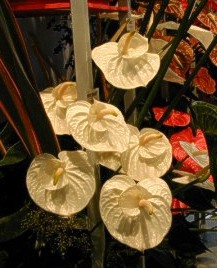
From the Ground up 10:
What goes into a fertilizer
Most parts of the United States require a label on each bag of fertilizer
that gives a great deal of information once you know what to look for.
Other countries have different requirements, and the labels are not always
as informative.
Let's consider nitrogen this time. It is one of the materials required in greatest amounts for plant growth (but please read some back issues of this magazine, since I doubt that much of the fertilizer sold is really needed except for the bottom profit line of the manufacturers) We will assume that after sensible consideration of your soil conditions, you have decided that you need nitrogen in your fertilizer program.
Most labels give the total amount of nitrogen in the mix (it will be the first of the three or four numbers given as the guaranteed analysis). This number for the total nitrogen may be broken down into subcategories, which are usually listed in the order in which they are available to the plant. The wording varies, but Nitrate nitrogen comes first: it is soluble in water and moves through the soil easily. It is the form that is most easily taken up by plants, is available whether the temperature is high or low, but, because it is soluble, it is the form most easily washed out of the soil and lost.
Ammoniacal nitrogen is also water soluble, and some is taken up directly by the plant. But most needs to be converted to the nitrate form by microorganisms in the soil before it gets into the plant. These microorganisms work better in warm temperatures than cold, so the ammoniacal nitrogen may not be as available in the early spring or the late fall. As ammoniacal nitrogen is converted to nitrate it acidifies the soil - a very useful characteristic in areas with soils of high pH
Water-soluble organic nitrogen usually means a synthetic chemical called urea. It is rather confusing, but "organic" in this sense only means that the compound contains carbon. The chemists have had their way with us here, so if you are looking for nutrients that come from a living source, you must not be taken in by the word organic in this context: the nutrient may not have come from something that was recently alive. Urea passes into solution easily, but must be converted to ammonaical nitrogen and then probably to the nitrate form before the plant makes use of it. Both these changes are done to a large extent by microorganisms in the soil, which is a reason for trying to maintain a living soil, rich in microbes of all sorts.
The final category often seen is water insoluble nitrogen. This used to be the category to seek if you wanted a natural origin, at the time when fertilizers used byproducts such as tankage or manure or dried blood. It still may mean that, but it also includes materials such as IBDU or sulfur-coated urea which break down only slowly to release their nitrogen.
How would you choose between these nitrogen sources? For a quick green-up go for nitrate, particularly if the weather is cool. This will be a little more expensive than ammoniacal materials or urea, which will be almost as fast in the warm season For a longer-lasting material, look for the water-insoluble category, and expect to pay a little more. There are more details of the source of material in a paragraph lower down the bag called "Derived from", which tells the actual materials that have been mixed in the bag to give the analysis quoted.
All of the above on the rate at which the fertilizer is available assumes that it is a granular type as opposed to a controlled release product in which portions of the fertilizer (sometimes an exact mix of everything in it and sometimes with the materials treated separately to various degrees) are coated with something that affects the availability to the soil solution. A plastic coating of some sort is the most common, applied very precisely, and with controlled properties, to allow the manufacturer to state that under certain temperature and rainfall conditions the fertilizer will have a particular 'release curve', so that you know that for much of the guaranteed life of the product a steady flow of nutrients will occur. The price of these is obviously going to much greater than other types.
What else about nitrogen as a plant nutrient? Be a little careful. It is a material that is needed and used by all plants, but it is easy to get out of balance with other nutrients and get growth that is soft and succulent, when what you need is strong, balanced growth. A little goes a long way in greening plants, and it is usually better to keep the ratio of nitrogen (first number in the analysis) to potassium (the third) to about 1:1. More on all this next time.
Back to Table of contents